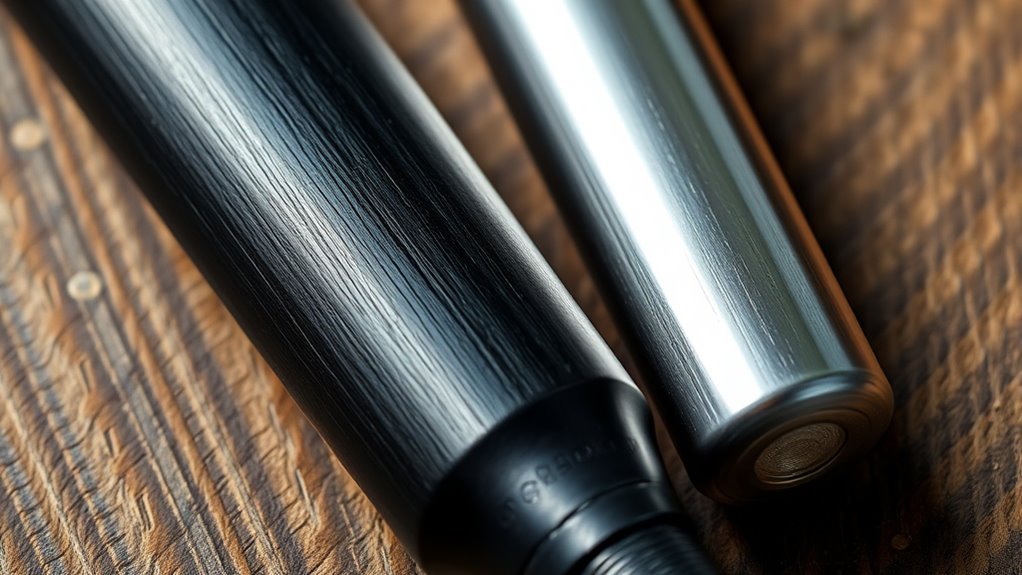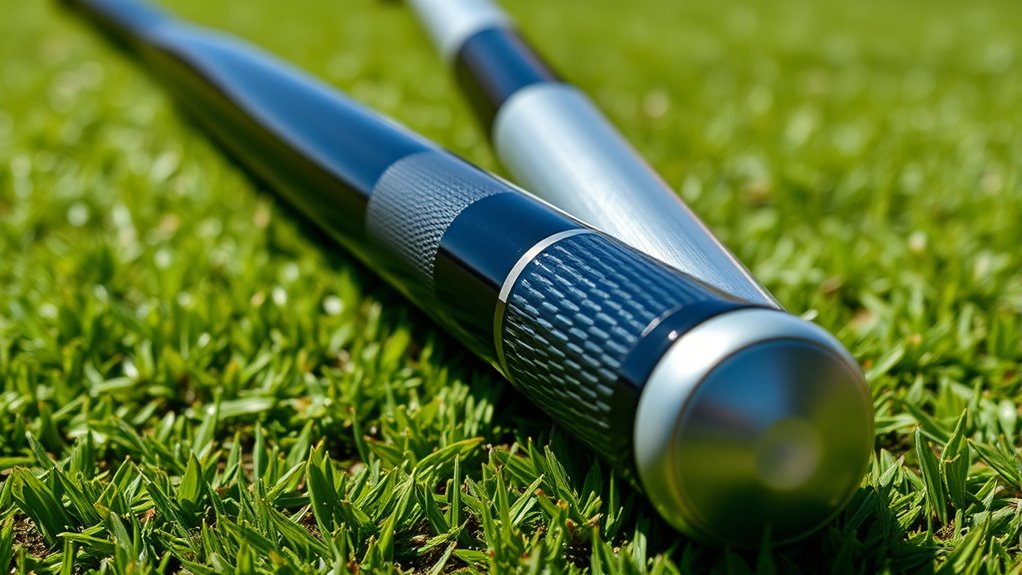If you’re choosing between composite and aluminum bats, consider your priorities. Aluminum bats deliver immediate response, durability, and perform consistently in various weather conditions, making them great for long-term use and frequent play. Composite bats offer a softer feel, potential for more distance, and usually require a break-in period but are more delicate and sensitive to cold. To find out which option best fits your game and needs, continue exploring the differences and advantages.
Key Takeaways
- Aluminum bats offer immediate response, durability, and consistent performance, making them ideal for frequent use and varied weather conditions.
- Composite bats provide a softer feel, higher performance after break-in, and potentially increased distance, but require careful handling.
- Aluminum bats are more resistant to cracking and temperature fluctuations, suitable for long-term and outdoor play.
- Composite bats may lose pop in cold weather and need proper maintenance, favored by players seeking a softer swing feel.
- Choose aluminum for durability and reliability; opt for composite for enhanced performance and softer touch once broken in.

When choosing between composite and aluminum bats, understanding their differences can help you make the best decision for your game. One of the key factors to consider is bat performance, which directly impacts how well you can hit the ball and control your swing. Aluminum bats tend to deliver a more consistent and immediate response. They typically have a larger sweet spot, making it easier to make solid contact, especially for players who prefer a faster swing speed. On the other hand, composite bats usually require a break-in period but can offer a higher level of performance once fully broken in. They often produce a softer, more balanced feel, which some players find more comfortable and controlled. Additionally, many players and coaches consider bat technology an important aspect in choosing the right bat, as innovations continually improve performance and durability.
Aluminum bats offer consistent, immediate response with a larger sweet spot for easier solid contact.
Durability is another important aspect when comparing these two types of bats. Aluminum bats are generally more durable and resistant to cracking or breaking, which makes them a good choice if you want a bat that can withstand frequent use over multiple seasons. They tend to hold up well against rough handling and are less sensitive to temperature fluctuations. Conversely, composite bats tend to be more delicate. They can crack or shatter if used improperly or subjected to hard impacts, although modern manufacturing has improved their durability. Still, they usually require more careful handling and proper storage to extend their lifespan. If durability is a top priority, aluminum bats are often the safer choice for long-term use.
Another consideration is how each bat type performs in different conditions. Aluminum bats perform consistently regardless of temperature, whereas composite bats can lose their pop in colder weather if not properly maintained or if they haven’t been broken in thoroughly. This makes aluminum bats more reliable for outdoor play in a variety of climates. Additionally, composite bats often have a more “trampoline-like” effect, which can translate to increased bat performance once broken in. They tend to produce a smoother swing feel and sometimes a slight increase in distance, especially for experienced players who know how to maximize their performance.
Ultimately, your choice depends on what you value most—whether it’s the consistent performance and durability of aluminum or the potentially higher performance and softer feel of composite bats. Both types have their advantages, but understanding these key differences helps you select the right bat to enhance your game and enjoy every swing.
Frequently Asked Questions
Are Composite or Aluminum Bats More Durable Over Time?
When choosing between composite and aluminum bats, consider their material durability and bat lifespan. Aluminum bats tend to be more durable over time, resisting dents and cracks better with frequent use. Composite bats may offer a better feel initially but can develop cracks or weaken faster if not cared for properly. Ultimately, aluminum usually provides a longer-lasting option, making it ideal if you want a durable bat for regular play.
Do Composite Bats Perform Better in Cold Weather?
Imagine the chill of winter as a test of resilience—does your bat perform better in cold weather? Generally, composite bats tend to lose performance in cold weather because the cold makes their materials less flexible, reducing bat performance. Aluminum bats, however, handle cold better, maintaining their durability and swing speed. So, if you’re playing in chilly conditions, aluminum bats might be your best choice for consistent performance.
How Do Weight Differences Impact Swing Speed?
Weight differences substantially impact your swing speed by influencing your swing mechanics. If you choose a heavier bat, it takes more effort to generate bat speed, possibly slowing down your swing. Lighter bats allow for faster swing mechanics, increasing bat speed and making it easier to make solid contact. Finding the right weight helps optimize your swing mechanics, so you can improve your overall swing speed and performance at the plate.
Are There Specific Leagues That Prefer One Material Over the Other?
Think of league preferences as a game of chess, where each league chooses their favored material trend. Some leagues, like youth or recreational ones, often prefer aluminum for its affordability and durability, while others, such as college or amateur leagues, lean toward composite bats for their performance benefits. Your choice depends on league rules, but knowing these material trends helps you stay ahead and play your best.
Can I Convert My Aluminum Bat to a Composite One?
You can’t convert your aluminum bat to a composite one because of material compatibility. Bat conversion isn’t feasible since aluminum and composite bats are built with different materials and internal structures. Attempting a conversion could compromise safety and performance. Instead, consider purchasing a new composite bat designed for your league. Always check league regulations before making a new purchase, and choose a bat that matches your playing needs.
Conclusion
Choosing between composite and aluminum bats is like picking the right paintbrush for your masterpiece—you want precision, power, and the perfect feel. Composite bats offer a smooth, springy dance with the ball, while aluminum bats deliver a lightning-fast snap of energy. Think of it as selecting your own musical instrument; whichever you choose, make sure it’s tuned to your style. Ultimately, your swing’s rhythm will turn your decision into a home run.









